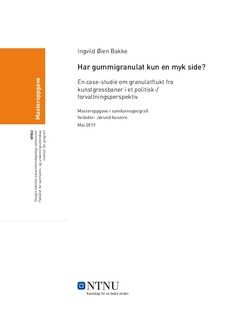| dc.contributor.advisor | Aasetre, Jørund | |
| dc.contributor.author | Bakke, Ingvild Øien | |
| dc.date.accessioned | 2019-08-25T14:06:59Z | |
| dc.date.available | 2019-08-25T14:06:59Z | |
| dc.date.issued | 2019 | |
| dc.identifier.uri | http://hdl.handle.net/11250/2610847 | |
| dc.description.abstract | Denne masteravhandlingen er en case-studie som omhandler utslipp av gummigranulat fra kunstgressbaner i Trøndelag. Avhandlingen søker å besvare problemstillingen: «I et politisk-/forvaltningsperspektiv; hva forårsaker granulatflukt fra kunstgressbaner som følgelig kan få konsekvenser for naturmiljøet?», hvor oppgavens formål er å kartlegge i hvor stor grad gummigranulat utgjør en fare for miljøet, årsaker til granulatutslipp og hvordan utslippet kan avverges.
Stadig større fokus på helårsaktivitet i fotballen har ført til flere etableringer av kunstgressbaner. Det har medført økt bruk av gummigranulat og større behov for gode drifts- og vedlikeholdsrutiner for å unngå granulatutslipp. Politiske strukturer avgjør hvilke beslutninger som blir tatt og hvilke tiltak som iverksettes. Beslutningene og tiltakene knyttes til maktfordelingen i forvaltningssystemet og hvordan ulike komponenter i systemet avgjør hvordan drifts- og vedlikeholdsarbeid gjennomføres. Det teoretiske rammeverket for å besvare dette ledes an av urban politisk økologi og governance som ser på forholdet mellom samfunn og natur, og politiske strukturer som former dette forholdet. For å få innblikk i og forståelse av hvordan beslutninger blir tatt og på hvilket grunnlag, ses det på aktørers subjektive meninger vedrørende kunstgressforvaltning. For å fremme deres subjektive meninger ble det i datainnhentingen brukt kvalitativ forskningsmetodikk i form av semi-strukturert intervju. Aktørgruppene som diskuteres er offentlige myndigheter, idretten og private bedrifter. Alle har de ulike forventinger til bruk av gummigranulat, men et felles mål om en bærekraftig og miljørettet produksjon, bruk og avfallshåndtering av produktet.
Gummigranulat som miljøtrussel blir vurdert ut fra hvordan produktet produseres, brukes og behandles som avfall. Forskning viser at det foreløpig ikke finnes et bedre alternativ til innfyll i kunstgressbaner enn gummigranulat, og at problemstillingene rundt forvaltningen av fotballanlegg derfor må rettes mot tiltak som gjør bruk av gummigranulat miljømessig og økonomisk bærekraftig. Løsninger som diskuteres er krav til drift og vedlikehold som skal holde granulatet på banen, og innovative løsninger som vil forlenge bildekkets livsløp og øke gummigranulatets ressurseffektivitet gjennom metabolske og sirkulære prosesser som åpner opp for økt bærekraft og nye økonomiske evalueringer. | |
| dc.description.abstract | This thesis offers a case study discussing the emission of rubber granules from artificial turfs in Trøndelag. It seeks to answer the thesis statement: “In a political/management perspective; what causes granule escape from artificial turfs which in turn may have consequences for the natural environment?”, where the purpose of the thesis is to map out the degree to which rubber granules make up a danger for the environment, reasons for granules emission and how emission may be averted.
A greater focus on year-round activity in soccer has led to several establishments of artificial turfs. This has in turn led to increased use of rubber granules and a greater need for satisfying operating and maintenance routines to avoid granule emissions. Political structures determine which decisions and measures are made. The decisions and measures are linked to the separation of power in the governance system and how different components in the system determine how operating and maintenance are implemented. The theoretical framework to answer this is led by urban political ecology and governance which analyze the relationship between society and nature, and political structures which shape this relationship. To earn insight and understanding of how decisions are made and on what grounds, the subjective opinions of the actors concerning artificial turf governance are discussed. Qualitative research methodology in the form of semi structured interviews were used in the data collection to promote the actors’ subjective opinions. The groups of actors who are discussed are public authorities, representatives from the sport (soccer), and private companies. They all have different expectations to the use of granule, but a joint aim where they want a sustainable and environmental production, use and waste of the product.
Rubber granule as an environmental threat is measured by how the product is produced, used and treated as waste. Research show that there currently is no better alternative to refill in acritical turfs than rubber granules, and that the issue concerned with the management of soccer facilities must therefore be aimed at measures which will make the use of rubber granules environmentally and financially sustainable. Solutions which will be discussed in this thesis are demands to operations and maintenance intended to keep the granules on the field, and innovative solutions which will extend the life cycle of the car tire as well as extending the resource efficiency of the rubber granules through metabolic and circular processes which open up for increased sustainability and new financial evaluations. | |
| dc.language | nob | |
| dc.publisher | NTNU | |
| dc.title | Har gummigranulat kun en myk side? | |
| dc.type | Master thesis | |
